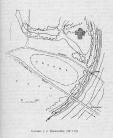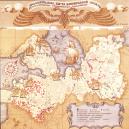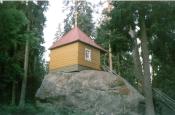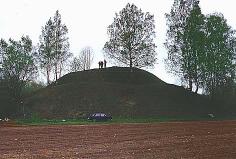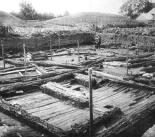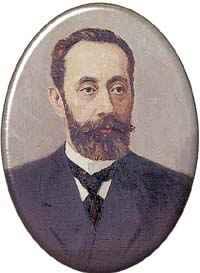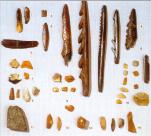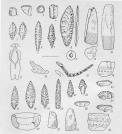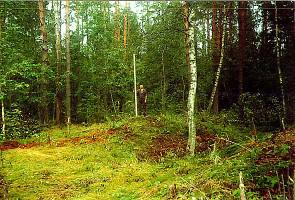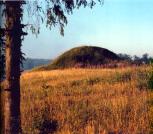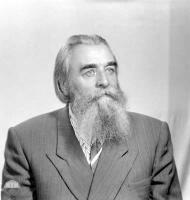|
hidden
|
Ancient settlements (selishche)
Selishches, remains of unfortified settlements, discovering according to the presence of the culture lay and withdrawn material. The search of ancient settlements is embarrassed for lack of external indications. More then 120 ancient settlements... more
|
|
|
|
hidden
|
Archaeological monuments
Archaeological monuments of the Leningrad Oblast are settlements, grads, burial grounds, religious objects and other material trails of the past. Settling the oblast territory took place during the Mesolithic period. The age of the most ancient... more
|
|
|
|
hidden
|
Brandenburg, Nikolay Yefimovich (1839-1903), a scientist
Brandenburg, Nikolay Yefimovich (1839-1903), a military historian, archaeologist, Lieutenant-General (1896). After finishing the Konstantin Military School in 1858, he served in artillery units. In 1861, keeping on the military sevice, Brandenburg... more
|
|
|
|
hidden
|
Burial grounds of the Izhora people.
Burial grounds of the Izhora people are concentrated in the Izhors tribe land in the Izhora and Neva rivers basin and on the south coast of the Gulf of Finland (see: Izhora). There are the data about 33 soil burial grounds. Excavations were made... more
|
|
|
|
hidden
|
Burial grounds of the Karelian people.
Burial grounds of the Karelians ( chronicle Korela, ancestors of the modern Korelians/Karyala) are concentrated in the north-western Ladoga Lake region (Priozersk district, joining districts of Karelia). There are known funeral monuments of the... more
|
|
|
|
hidden
|
Burial grounds of the Vod people.
Burial grounds of the Vod. Funeral sites of the North-western Vod ("Chud") were explored by E.A. Ryabinin in 1983-1988 in the former Vod parish of Kattila (Kotli Village of the Kingisepp district). The oldest type is presented by stone burial... more
|
|
|
|
hidden
|
Commission for the Archaeologic Research of the Leningrad Oblast
The Commission for the Archaeologic Research of the Leningrad Oblast. In 1919 the Russian Academy of the Material Culture History (RAIMK, later GAIMK) was esatblished in Petrograd. It was the predecessor of the conteporary centres of the Russian... more
|
|
|
hidden
|
Cult (worship) stones
Cult stones. The worship of cult stones was registered in all northern part of the East Europe including Baltic countries and Scandinavia. Track-stones, with deep image of a human foot track, are wide presented. Those images are sometimes... more
|
|
|
|
hidden
|
Culture of Mounds
The Culture of Mounds. Mounds are high steep-side hills with the flat top and with the circle made of boulders at the foot. The area of the mound culture include basins of Ilmen Lake, the Msta, Volkhov, Luga rivers. There are mounds in the Luga,... more
|
|
|
|
hidden
|
Dolengo-Khodakovsky, Zorian (Adam Charnotsky) (1784-1825), a scientist
Dolengo-Khodakovsky, Zorian (the real name is Adam Charnotsky) (1784-1825), a Polish archaeologist, a founder of the scientific Slavonic philology, a researcher and expert on Slav antiquities. In 1811 he joined the army of Napoleon and participated... more
|
|
|
hidden
|
Early Metal Epoch, the
The early Metal Epoch. In 2000 BC ancestors of the Finno-Ugric tribes, which include the local Neolithic population, mooved to the Leningrad Oblast territory from Verkhneye Povolzhye (the Volga River upperstream region). They brought the culture of... more
|
|
|
|
hidden
|
Fortified ancient settlements
Fortified ancient settlements (gorodishches), remains of fortified settlements protected with natural obstacles, ditches and banks. In the leningrad Oblast there are 30 fortified ancient settlements, they are mainly of cape type (15 of them are... more
|
|
|
|
hidden
|
"Friday", a stone
reference
|
|
|
hidden
|
Gurina, Nina Nikolayevna (1909-1990), a scientist
Gurina, Nina Nikolayevna (1909-1990), an archaeologist, a researcher of the Stone Age. During 1937-1930 Gurina attended the Moscow State University, then she worked at museums of Kandalaksha and Petrozavodsk towns. From 1935 Gurina worked at GAIMK... more
|
|
|
|
hidden
|
|
hidden
|
Inostrantsev, Aleksandr Aleksandrovich (1843-1919), a scientist
Inostrantsev, Aleksandr Aleksandrovich (1843-1919), a geologist, a professor of the St. Petersburg University (1873), a Corresponding Member of the St. Petersburg Academy of Sciences (1901). He graduared from the physico-mathematical faculty of... more
|
|
|
|
hidden
|
Ivanovsky, Lev Konstantinovich (1845-1892), a scientist
Ivanovsky, Lev Konstantinovich (1845-1892), a doctor, archaeologist, anthropologist. He graduated the Medical and Surgical Academy in 1869 with the gold medal and he was suggested to work as an assistant lecturer at the descriptive anatomy... more
|
|
|
hidden
|
Kurgans (barrows) of the southern Ladoga Lake region.
Kurgans (barrows, burial mounds) of the southern Ladoga Lake region (the late 9th - early 13th centuries) pertain to so-called the Lake Ladoga region Chuds whose descendants took part in forming Vepses and Karels. They were likely to be "kolbyagi",... more
|
|
|
|
hidden
|
Lebedev, Gleb Sergeyevich (1943-2003), a scientist
Lebedev, Gleb Sergeyevich (1943-2003, Staraya Ladoga Village), an archaeologist, a professor of the Leningrad/St. Petersburg University (1990). He graduated from the history faculty of the Leningrad State University in 1968, taught at the... more
|
|
|
|
hidden
|
Linevsky, Aleksandr Mikhailovich (1902-1985), a scientist
Linevsky, Aleksandr Mikhailovich (1902-1985), a writer, archaeologist and ethnographer. Linevsky was born in St. Petersburg, studied at the College of Jurisprudence (1912-1918) and at the Petrograd/Leningrad Iniversity (1923-1928). In 1929 he... more
|
|
|
|
hidden
|
Mesolithic monuments, The.
The Mesolithic monuments. Mesolithic (the Middle Stone Age) is the transitional epoch between the Palaeolithic period and the Neolithic period (in Europe - from c 10000 to 7000 BC). Microlite silicon tools, various goods made of bone and horn are... more
|
|
|
|
hidden
|
Neolithic monuments, The
The Neolithic monuments. The Neolithic (New Stone Age, 8000 - 3000 BC) is the epoch of farming and cattling appearance, spinning and weaving, new techniques of processing of stones and ceramics. In the Eastern Europe forest zone the Neolithics is... more
|
|
|
|
hidden
|
"Nevo", archeology - navigation expedition
reference
|
|
|
hidden
|
Old Russian Kurgans (barrows)
The Old Russian kurgans (barrows) are mounds over graves of the 10th-14th centuries. In old Russian towns barrow burials were stopped in the 11th century after adopting Christianity. The rural population continued to bury according to the Pagan... more
|
|
|
|
hidden
|
Oleg's grave, a tumulus
The burial of Oleg is a tumulus in Staraya Ladoga Village. The chronicle legend about the death of Prince Oleg (he died in AD 912) connects the place of his burial with Ladoga. In the vicinity of the mound there are known three necropolises... more
|
|
|
|
hidden
|
Peredolsk mound
reference
|
|
|
hidden
|
Ravdonikas, Vladislav Iosifovich (1894-1976), a scientist
Ravdonikas, Vladislav Iosifovich (1894, Tikhvin - 1976), an archaeologist, Corresponding Member of the Academy of Science of the USSR (1946). In the middle of the 1910s Ravdonikas has been keen on archaelogical dig of burial mounds of the Tikhvin... more
|
|
|
|
hidden
|
Repnikov, Nikolay Ivanovich (1882-1940), a scientist
Repnikov, Nikolay Ivanovich (1882-1940), an archaeologist, researcher of Staraya Ladoga and other archaeological sites of the Leningrad Oblast. From 1902 he worked at the Archaeology Committee and the Russian Archaeologic Society, after the... more
|
|
|
hidden
|
Site of the eathen fortified ancient settlement (Staraya Ladoga)
reference
|
|
|
hidden
|
Site of the fortified ancient settlement of Kaybolovo
reference
|
|



